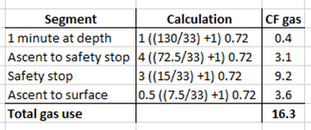- Messages
- 21,537
- Reaction score
- 21,801
- Location
- Philadelphia and Boynton Beach
- # of dives
- 2500 - 4999
I'm with @Diving Dubai, I make a very conservative calculation, knowing that there are many things I can do to decrease the amount of gas I use. However, I would rather have more gas than I need rather than too little. Having a buffer does take some of the emergency out of the emergency. I do the same calculation as used by @mi000ke
1) Emergency at 130 ft, the limit of my recreational diving
2) 1 minute at depth
3) An ascent rate of 30 ft/min to the safety stop and to the surface
4) A 3 minute safety stop
5) Gas consumption at twice my average RMV (I have my average RMV from my last 1200 dives)
Corrected spreadsheet, post #14, thanks @johndiver999
So, I chose a 19 cf pony. Using the above gas would leave me with about 425 psi from a full cylinder.
This is a simple calculation, anyone could make it using their own chosen variables.
1) Emergency at 130 ft, the limit of my recreational diving
2) 1 minute at depth
3) An ascent rate of 30 ft/min to the safety stop and to the surface
4) A 3 minute safety stop
5) Gas consumption at twice my average RMV (I have my average RMV from my last 1200 dives)
Corrected spreadsheet, post #14, thanks @johndiver999
So, I chose a 19 cf pony. Using the above gas would leave me with about 425 psi from a full cylinder.
This is a simple calculation, anyone could make it using their own chosen variables.




